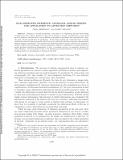| dc.contributor.author | Lieberman, Chad E. | |
| dc.contributor.author | Willcox, Karen E. | |
| dc.date.accessioned | 2013-03-15T15:25:34Z | |
| dc.date.available | 2013-03-15T15:25:34Z | |
| dc.date.issued | 2012-07 | |
| dc.date.submitted | 2012-05 | |
| dc.identifier.issn | 1064-8275 | |
| dc.identifier.issn | 1095-7197 | |
| dc.identifier.uri | http://hdl.handle.net/1721.1/77905 | |
| dc.description.abstract | Inference of model parameters is one step in an engineering process often ending in predictions that support decision in the form of design or control. Incorporation of end goals into the inference process leads to more efficient goal-oriented algorithms that automatically target the most relevant parameters for prediction. In the linear setting the control-theoretic concepts underlying balanced truncation model reduction can be exploited in inference through a dimensionally optimal subspace regularizer. The inference-for-prediction method exactly replicates the prediction results of either truncated singular value decomposition, Tikhonov-regularized, or Gaussian statistical inverse problem formulations independent of data; it sacrifices accuracy in parameter estimate for online efficiency. The new method leads to low-dimensional parameterization of the inverse problem enabling solution on smartphones or laptops in the field. | en_US |
| dc.description.sponsorship | United States. Air Force Office of Scientific Research (Multi University Research Initiative (MURI) Program) | en_US |
| dc.language.iso | en_US | |
| dc.publisher | Society for Industrial and Applied Mathematics | en_US |
| dc.relation.isversionof | http://dx.doi.org/10.1137/110857763 | en_US |
| dc.rights | Article is made available in accordance with the publisher's policy and may be subject to US copyright law. Please refer to the publisher's site for terms of use. | en_US |
| dc.source | SIAM | en_US |
| dc.title | Goal-Oriented Inference: Approach, Linear Theory, and Application to Advection Diffusion | en_US |
| dc.type | Article | en_US |
| dc.identifier.citation | Lieberman, Chad, and Karen Willcox. “Goal-Oriented Inference: Approach, Linear Theory, and Application to Advection Diffusion.” SIAM Journal on Scientific Computing 34.4 (2012): A1880–A1904. CrossRef. Web. © 2012, Society for Industrial and Applied Mathematics. | en_US |
| dc.contributor.department | Massachusetts Institute of Technology. Department of Aeronautics and Astronautics | en_US |
| dc.contributor.mitauthor | Lieberman, Chad E. | |
| dc.contributor.mitauthor | Willcox, Karen E. | |
| dc.relation.journal | SIAM Journal on Scientific Computing | en_US |
| dc.eprint.version | Final published version | en_US |
| dc.type.uri | http://purl.org/eprint/type/JournalArticle | en_US |
| eprint.status | http://purl.org/eprint/status/PeerReviewed | en_US |
| dspace.orderedauthors | Lieberman, Chad; Willcox, Karen | en |
| dc.identifier.orcid | https://orcid.org/0000-0003-2156-9338 | |
| mit.license | PUBLISHER_POLICY | en_US |
| mit.metadata.status | Complete | |
